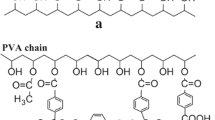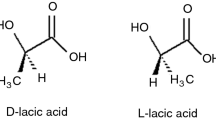Abstract
Novel poly(ε-caprolactone) (PCL)–glycerol polyester was synthesized in one step in the presence of Novozym 435 under mild reaction conditions. The objective of the study was to investigate the feasibility of enhancing the hydrophilicity of PCL by condensing it with glycerol through biocatalytic approach. Effect of reaction time, glycerol-to-CL ratio and CL-to-toluene ratio was studied. The 1H NMR and GPC results established that self-condensation of CL units and condensation of CL with glycerol units take place simultaneously. When the glycerol content was 10 and 20 mol% with regard to CL, condensation continued for 6 h; further extension of reaction time resulted in the cleavage of ester linkages. When the glycerol content was increased to 40 mol%, the condensation of CL–glycerol units was accomplished in 4 h; however, the reaction had to get extended beyond 6 h for complete condensation of CL–CL units. The study revealed that the crystallinity and the melting temperature (Tm) of the products altered with an increase in the glycerol content. Furthermore, TGA and contact angle values of water on PCL and its glycerol derivative films revealed that the water uptake capacity of PCL too increased significantly with the increase in glycerol content, rendering PCL more hydrophilic.








Similar content being viewed by others
References
Dash TK, Konkimalla VB (2012) Poly-є-caprolactone based formulations for drug delivery and tissue engineering: a review. J Control Release 158(1):15–33
Mondal D, Griffith M, Venkatraman SS (2016) Polycaprolactone-based biomaterials for tissue engineering and drug delivery: current scenario and challenges. Int J Polym Mater Polym Biomater 65(5):255–265
Salerno A (2016) Overview of polycaprolactone-based drug delivery system. In: Ravi Kumar MNV (ed) Handbook of polyester drug delivery systems, pp 187–212
Jiang Y-C, Jiang L, Huang A, Wang X-F, Li Q, Turng L-S (2017) Electrospun polycaprolactone/gelatin composites with enhanced cell–matrix interactions as blood vessel endothelial layer scaffolds. Mater Sci Eng, C 71:901–908
Park JS, Lee SJ, Jo HH, Lee JH, Kim WD, Lee JY, Park SA (2017) Fabrication and characterization of 3D-printed bone-like β-tricalcium phosphate/polycaprolactone scaffolds for dental tissue engineering. J Ind Chem 46:175–181
Sun H, Mei L, Song C, Cui X, Wang P (2006) The in vivo degradation, absorption and excretion of PCL-based implant. Biomaterials 27(9):1735–1740
Woodruff MA, Hutmacher DW (2015) The return of a forgotten polymer: polycaprolactone in the 21st century. Polym Test 43:94–102
Kang HU, Yu YC, Shin SJ, Kim J, Youk JH (2013) One-pot synthesis of poly (N-vinylpyrrolidone)-b-poly (ε-caprolactone) block copolymers using a dual initiator for RAFT polymerization and ROP. Macromolecules 46(4):1291–1295
Wei X, Gong C, Gou M, Fu S, Guo Q, Shi S, Luo F, Guo G, Qiu L, Qian Z (2009) Biodegradable poly(ɛ-caprolactone)–poly(ethylene glycol) copolymers as drug delivery system. Int J Pharm 381(1):1–18
Sheikh FA, Barakat NA, Kanjwal MA, Aryal S, Khil MS, Kim HY (2009) Novel self-assembled amphiphilic poly(epsilon-caprolactone)-grafted-poly(vinyl alcohol) nanoparticles: hydrophobic and hydrophilic drugs carrier nanoparticles. J Mater Sci Mater Med 20(3):821–831
Li Z, Tan BH (2014) Towards the development of polycaprolactone based amphiphilic block copolymers: molecular design, self-assembly and biomedical applications. Mater Sci Eng, C 45:620–634
Jahani H, Jalilian FA, Wu CY, Kaviani S, Soleimani M, Abassi N, Ou KL, Hosseinkhani H (2015) Controlled surface morphology and hydrophilicity of polycaprolactone toward selective differentiation of mesenchymal stem cells to neural like cells. J Biomed Mater Res A 103(5):1875–1881
Stefani S, Honzke S, Camacho JLC, Neumann F, Prasad AK, Hedtrich S, Haag R, Servin P (2016) Hyperbranched glycerol-based core-amphiphilic branched shell nanotransporters for dermal drug delivery. Polymer 96:156–166
Frey H, Haag R (2002) Dendritic polyglycerol: a new versatile biocompatible material. J Biotechnol 90(3–4):257–267
Kulshrestha A, Gao W, Gross RA (2005) Glycerol copolyesters: control of branching and molecular weight using a lipase catalyst. Macromolecules 38(8):3193–3204
Li Z, Zhang Z, Liu KL, Ni X, Li J (2012) Biodegradable hyperbranched amphiphilic polyurethane multiblock copolymers consisting of poly(propylene glycol), poly(ethylene glycol), and polycaprolactone as in situ thermogels. Biomacromol 13(12):3977–3989
Cai T, Li M, Zhang B, Neohab K-G, Kang E-T (2014) Hyperbranched polycaprolactone-click-poly(N-vinylcaprolactam) amphiphilic copolymers and their applications as temperature-responsive membranes. J Mater Chem B 2:814–825
Zheng Y, Turner W, Zong M, Irvine DJ, Howdle SM, Thurecht KJ (2011) Biodegradable core-shell materials via RAFT and ROP: characterization and comparison of hyperbranched and microgel particles. Macromolecules 44(6):1347–1354
Huskic M, Pulko I (2015) The synthesis and characterization of multiarm star-shaped graft copolymers of polycaprolactone and hyperbranched polyester. Eur Polym J 70:384–391
Li Z, Li J (2013) Control of hyperbranched structure of polycaprolactone/poly(ethylene glycol) polyurethane block copolymers by glycerol and their hydrogels for potential cell delivery. J Phys Chem B 117:14763–14774
Kumar A, Gross RA (2000) Candida antarctica lipase B-catalyzed transesterification: new synthetic routes to copolyesters. J Am Chem Soc 122(48):11767–11770
Deng F, Gross RA (1999) Ring-opening bulk polymerization of ε-caprolactone and trimethylene carbonate catalyzed by lipase Novozym 435. Int J Biol Macromol 25(1–3):153–159
Meyer U, Palmans ARA, Loontjens T, Heise A (2002) Enzymatic ring-opening polymerization and atom transfer radical polymerization from a bifunctional initiator. Macromolecules 35(8):2873–2875
Kobayashi S, Uyama H, Takamoto T (2000) Lipase-catalyzed degradation of polyesters in organic solvents: a new methodology of polymer recycling using enzyme as catalyst. Biomacromol 1(1):3–5
Crescenzi V, Manzini G, Calzolari G, Borri C (1972) Thermodynamics of fusion of poly-β-propiolactone and poly-ϵ-caprolactone. Comparative analysis of the melting of aliphatic polylactone and polyester chains. Eur Polym J 8:449–463
Iida S (1981) Effect of entanglement on crystallinity of semicrystalline polymer. Kobunshi Ronbunshu 38(5):291–299
Acknowledgements
The authors would like to acknowledge the Loyola Schools faculty grant for scholarly work committee for financial support and Mr. Adam Ferry for performing some of the experiments. This work was partly supported by JST PRESTO “Molecular Technology” under the direction of Prof. Takashi Kato.
Author information
Authors and Affiliations
Corresponding author
Rights and permissions
About this article
Cite this article
Chakraborty, S., Pagaduan, J.N.M., Melgar, Z.K.A. et al. Glycerol-modified poly(ε-caprolactone): an biocatalytic approach to improve the hydrophilicity of poly(ε-caprolactone). Polym. Bull. 76, 1915–1928 (2019). https://doi.org/10.1007/s00289-018-2443-6
Received:
Revised:
Accepted:
Published:
Issue Date:
DOI: https://doi.org/10.1007/s00289-018-2443-6




